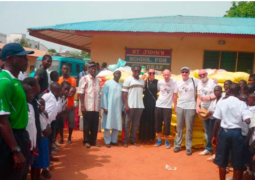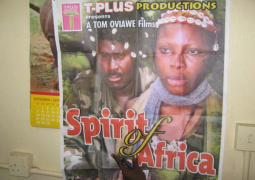
The
Casamance region’s ethnic, religious, and cultural composition is different from
the rest of Senegal, and since independence, the southern population has
protested the north’s domination of national politics and resources. The MFDC
emerged as an armed separatist movement in 1982, and with violence peaking in
the 1990s, the United Nations estimates the fighting has killed over 5,000
people, internally displaced over 60,000, and sent tens of thousands into
refuge in neighboring Guinea-Bissau and the Gambia.
Calling
the separatist movement “Senegal’s toughest problem,” Sall made peace in the
Casamance a key initiative of his 2012 election platform, and seems genuinely
committed to ending the conflict. His willingness to negotiate with an
inclusive range of MFDC factions has paid dividends, as have the multiple,
youth-oriented development projects his regime has launched in the Casamance.
After months of mediation through Sant’Egidio, a Catholic lay organization
based in Rome, the leader of the MFDC’s most militant and powerful faction,
Salif Sadio, publically agreed to a ceasefire and the commencement of formal
peace talks. Government concessions – which included the dropping of charges
against key rebel leaders and promises to promote the economic development and
political integration of the Casamance region – were key factors in the agreement
and increase the odds that the ceasefire will be endorsed across the MFDC
movement. (David Seyferth, 2014)
Agriculturally
one of the potential richest regions in Senegal, the Casamance has suffered
from the effects of an 18-year separatist movement. Civilians have been
displaced, and many have lost their means of livelihood. Land mines have been
laid in many formerly productive areas. Villages have been abandoned.
Infrastructure has been neglected, and investment has come to a virtual
standstill.
The
causes of the conflict and its perpetuation are complex. Factors often cited as
contributors include historical factors, economic neglect, lack of job
opportunities for youth, land rights issues, and disrespect for indigenous
cultural norms. The conflict has had negative effects on virtually every aspect
of life in the Casamance: the environment has degraded due to uncontrolled
exploitation or neglect, normal village life and social support systems have
been disrupted, poverty has increased, the cities are overcrowded, schools and
health posts have been closed or displaced, and investment and tourism have
declined.
In
1982, supporters of the Mouvement des Forces Democratiques de la Casamance
demanded that the Government of Senegal grant independence to the Casamance
region, an isolated section of southwestern Senegal located between Gambia and
Guinea-Bissau. This demand sparked a two-decade-long conflict, which only
recently began to be resolved.
The
conflict worsened in the late 1990s with the appearance of anti-personnel and
anti-tank mines. These landmines have adversely affected the population,
agricultural activities and tourism, as well as hampering donor and NGO efforts
in the region. No accurate information is available regarding the total
quantity of landmines or the number of landmine casualties. Over the years,
hundreds of villages have been abandoned and schools and health centres have
closed. Hundreds of children and women have become victims of landmines and
risk of exposure to sexually transmitted infections (STIs) and HIV/AIDS has
increased due to population displacement, the presence of combatants and
increased poverty. The nutritional status of children has also deteriorated.
Are
we today on the verge of a new round of military intervention? A sober debate
over military intervention might benefit from a brief look back into history.
We are seriously concerned over the trend towards the normalization of military
intervention into situations designated as humanitarian crises. The world must
not be allowed to return to the situation before 1940, when international law
was little more than ink on paper. The discontent of (parts of) a population in
a given country cannot be used as an excuse to destabilize, attack or occupy
weaker countries, thereby undermining the international legal order.
Humanitarian
interventions are often defended under the premise that all else has been tried
and failed. In reality, it is usually the Western powers that undermine a
negotiated settlement, or fail to give negotiations a reasonable chance. This
was the case in Kuwait (1990), in Somalia (1993) and in the former Jugoslavia
(1996-1999). It also holds true over the past decade. The South African
president did not complain without reason to the UN Security Council, arguing
that the African Union had been pushed aside in the search for a negotiated
settlement in Libya. Moreover, the West continues to fuel conflict by arming,
training and financing one (or more) of the conflicting parties. Also has
demonstrated very well its dangers and capacity for catastrophic failure.
We
cannot accept that the West compensates for its waning global power by using
humanitarian military interventions as a cover for pursuing geostrategic
interests. We can no longer look on passively as powerful economic interest
groups set out to conquer the world “in our name.” We stand against the
politics of intervention, even when it wraps itself in the cloak of
humanitarianism. A wolf remains a wolf, even when dressed in sheep’s clothing.
(Ludo De Brabander, 2012)
Conflict
can affect the level of development in a country in a number of ways. Firstly,
conflict is likely to disrupt the distribution of food and other resources to
the population. It is argued that the main cause of the 1984 famine in Ethiopia
was not drought or overpopulation, but the fact that the food could not be
distributed to the people due to the sheer size of the country and the scale of
the war which was going on at the time. Secondly, many services, such as
schools, are devastated by conflict which can cause literacy rates to fall - an
indicator which is often seen as the key to more widespread development. Also,
conflict can cause an imbalance in the population structure, as men of economic
age are those most likely to be involved in the fighting.
If
military intervention the solution to the Cassamanse conflict, then?
How
many shall die?
How
many shall make it to the refugee camps?
How
many shall lose their business?
How
many shall be homeless?
How
many shall be raped?
How
many shall commit suicide?
How
many shall be separated from their families and loves ones?
How
many shall migrate?
How
many shall live in hunger?
how
many shall take the gun to retaliate?
How
many pregnancies shall be aborted?
How
many shall be crying both day and night?
And
how many of her resources shall be looted?
I
may never be President of Cassamance, but at least I have earned unreserved
rights to good governance by virtue of my citizenship and my law-abiding
nature. I, hereby, do solemnly pledge to consistently and continually fight for
this noble right of mine, along with those who care to join me towards
liberating Cassamance.
Finally,
at the end of the day, military intervention does nothing to resolve the
underlying reasons for conflict in Cassamance. More often than not, conflict is
the result of poverty or socio-economic Inequality, which in turn has its
origins in destabilizing agricultural, trade and debt policies emanating from
Western dominated institutions. The resources wasted on military intervention
might otherwise have sufficed to pursue policies aimed at social development,
which might in turn have contributed to the prevention of violence.
To
be continued……..



